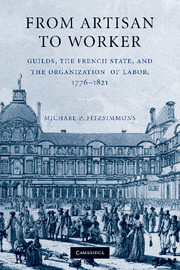Introduction
Published online by Cambridge University Press: 06 July 2010
Summary
Some of the work that has long been recognized as among the most innovative scholarship on the French Revolution centered on workers, particularly their politicization. Paradoxically, however, as Haim Burstin noted some years ago, there is a lack of a history of work during the French Revolution. Although Burstin himself has done as much as anyone to address this void, his observation is as valid now as it was then.
The subject of work during the Revolution, of course, is large and multi-faceted, but this study has as its focal point the organization of labor – more specifically, the issue of guilds and the Revolution. Guilds, or corporations, as they were also known, and the terms will be used synonymously, were abolished in 1791, destroying a structure of work that had been in place for centuries. Although they were never brought back in any comprehensive fashion, they remained the object of a vigorous and prolonged debate, with the advantages and disadvantages of their reestablishment considered. Their abolition was perceived by many as misguided, a view shared in some cases by deputies and administrators; others argued, more strongly, that their destruction had been a mistake and advocated for their restoration.
One reason that the debate on whether or not to restore guilds, which continued for decades, has attracted little attention may be due to the thematic focal points utilized by historians of French labor for the centuries flanking the Revolution and Empire.
- Type
- Chapter
- Information
- From Artisan to WorkerGuilds, the French State, and the Organization of Labor, 1776–1821, pp. 1 - 6Publisher: Cambridge University PressPrint publication year: 2010

